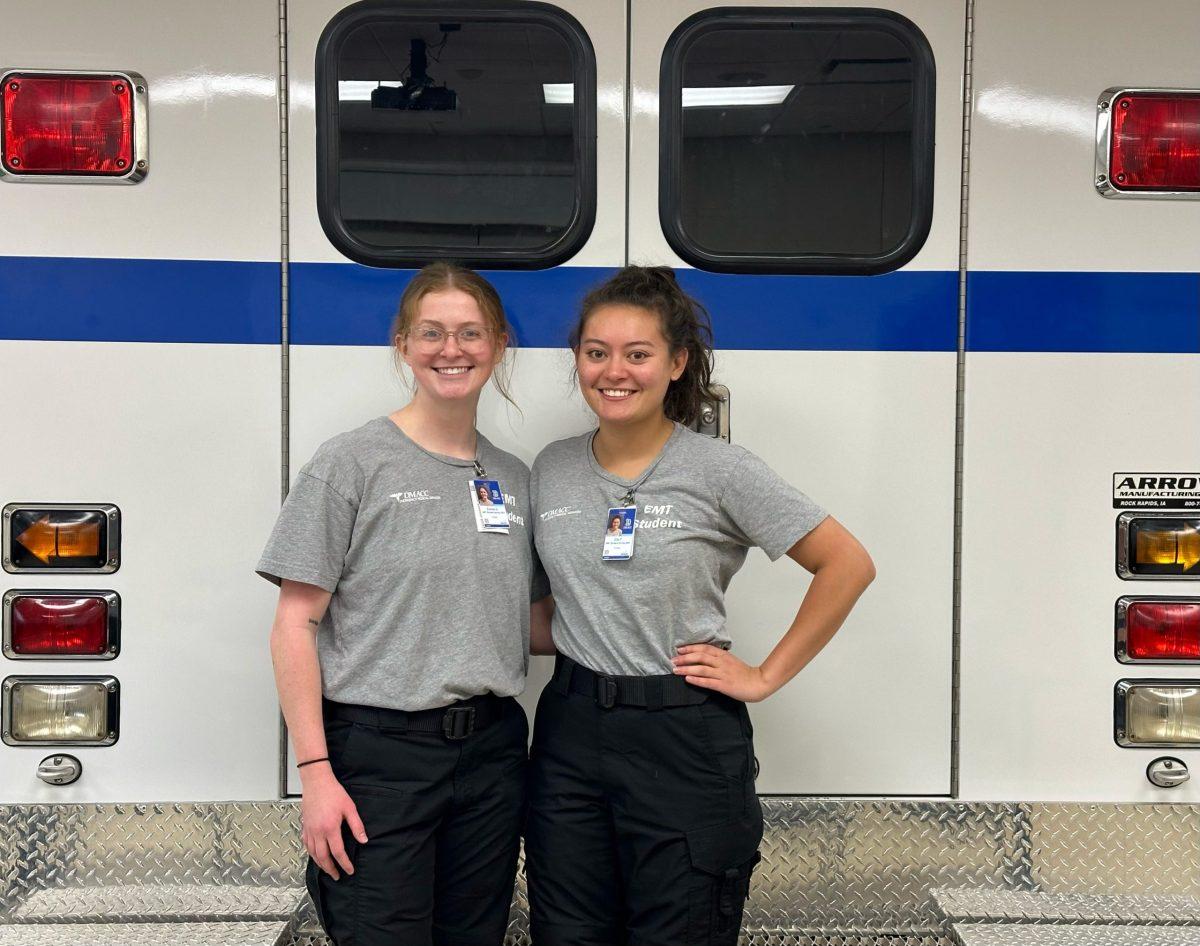Every semester, Des Moines Area Community College offers the Emergency Medical Technician program on their Ankeny campus.
The course prepares students to gain an EMT license. While it is a DMACC course, there is Drake University participation. Seniors Emma Garfoot and Elle Forsmark are enrolled in the program, and Assistant Director for the First-Year Experience Sara Schilling is an adjunct instructor.
In addition to meetings from 6 p.m. to 10 p.m. twice a week for a semester, the program requires students to sign up for clinical and field internships. This includes shifts in an emergency room and riding along with ambulances and fire departments.
“[We] see our skills that we learned in the classroom put into situations and are able to get [that] hands-on experience,” Garfoot, a health science and pre-med student, said.
The two Drake students involved in this program say the program has been very beneficial in not just additional knowledge, but future career plans as well.
“With an EMT license, you can either work at a hospital in the ER [or] at a fire department as patient transport,” Forsmark, who is studying health sciences on the clinical and medical track, said. “That’s something important to me. I want to be helping patients and treating patients.”
Not all students enrolled in this program plan on becoming EMTs. Garfoot plans on going into medical school after graduating from Drake with the aim of being involved in OBGYN fields.
“I am very passionate about women’s health,” Garfoot said. “Having experiences as an EMT and learning about OBGYN things definitely solidifies my goals. If any doubts [about my future] existed prior to starting this program, they’re gone.”
The program ends in May, but Forsmark still feels she has more to learn and experience.
“The most meaningful part would be learning and helping,” Forsmark said. “I haven’t really gotten to do a ton yet, but crossing my fingers that my clinicals will go well and I’ll get a lot of experience treating patients.”
The EMT program also provided an opportunity for students to get into the field and learn through experience after COVID-19.
“Coming to college at the beginning of the pandemic took away a lot of opportunities for students to be in the clinical setting and learn,” Forsmark said. “I really wanted to get out there [and] learn some more skills that would be useful for my desired career path.”
Schilling was in the program herself in the fall of 2013. After graduating from paramedic school in 2016, she started working with the lab and teaching hands-on skills. As an instructor, Schilling has been able to see a different side of the program than students.
“I think it’s really cool to see the EMTs that I’ve taught out and about in the world doing EMT things,” Schilling said. “They’ve become successful and are enjoying their jobs, and it’s extra cool to see those that are passionate about [Emergency Medical Services] and jump right into the paramedic program.”
Garfoot is one of four women in the class, one of which is trying to get on the fire squad. The rest of the class are men. One man in her class used to be a medical examiner. One is a formal funeral director. While every student comes from different backgrounds, the nature of the class forces them to be close.
“Every skill that we do that is non-invasive we practice on each other,” Garfoot said. “We’re backboarding each other, we’re doing cervical collars on each other. We’re doing medical and trauma assessments, and so you’re getting good up close and personal with these people, even if you didn’t want to. I’ve learned so much about people’s histories.”
However, situations as an EMT are very different from classroom environments.
“It’s so different putting a 12-lead on a mannequin versus putting a 12-lead on a real person,” Garfoot said. “All anatomical landmarks are different from person to person. Just getting hands-on experience has been very eye-opening.”
Each ride-along shift is different. Sometimes all the student does is take blood pressure, but sometimes they administer medication and place 12-leads, a portable heart test that allows the medical personnel to see the patient’s heart activity.
“For the first shift, it’s not like they just dropped you in the deep end,” Garfoot said. “[The firefighters and nurses] know your students. They know that we don’t need our hands held, but we do need support going into it. We all know how to do it. If it’s within our scope, they basically will let you try it, which is really good. It makes you feel like you’re a real EMT, not just playing EMT.”
Being in the field can be stressful, so instructors try to give students strategies to deal with that.
“If you see someone whose leg is broken and they’re bleeding a lot but they’re screaming, then you know, they have an airway. You know that they’re most likely getting adequate ventilation and are conscious and are alert to verbal stimuli,” Garfoot said. “If you see another person and there’s no obvious blood but they’re unresponsive, you can’t get tunnel vision to [only focus on] blood and bone. [We try] to break these pathways we’ve already built over our entire lives of thinking, ‘Oh, that looks bad, so it must be bad.’ That’s not always the case.”
Clinical shifts in emergency rooms are also an essential part of the program. While it may not be as stressful as ride-alongs, meaningful experiences can still happen.
“This person was looking at me and asking for my help because they recognize I am in a position where I am able to help them,” Forsmark said. “That was the first time that someone had said that to me.”
While each student learns everything they need to in the program, it can still be easy for them to doubt their skills.
“The hardest part would have to be being confident enough in my abilities in treating patients,” Forsmark said. “As a student, you feel like you have to hold back. Reminding myself that I do have the skills, I do have the knowledge and I do know what I’m doing has been a little more difficult.”
Part of the EMT class is assessing a patient. That means figuring out why they called emergency medical services, ensuring they don’t have life-threatening trauma and finding what’s wrong with them. Each student gets a sheet at the beginning of the semester with everything they will learn by the end of the program.
“It looks very, very daunting at the start,” Schilling said. “ And then one day, it just clicks. You go through it without having to look at the sheet, and you just do it and you do it well. I tell students it happened to me, and I’ve seen it happen before. I promise by the end of the class, you will get there, and they all look so skeptical. The day it clicks, it makes sense. I think seeing that is pretty cool.”








